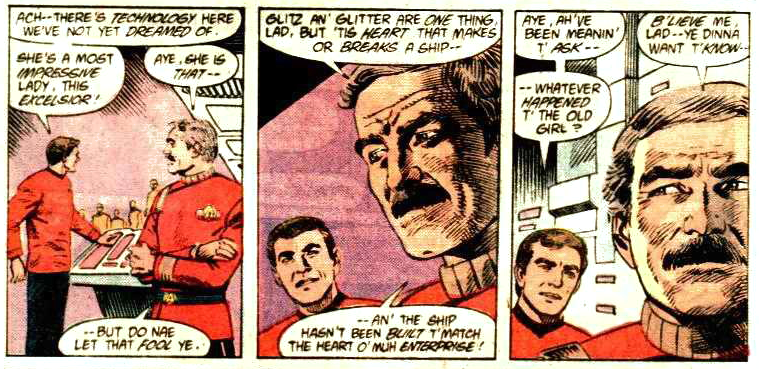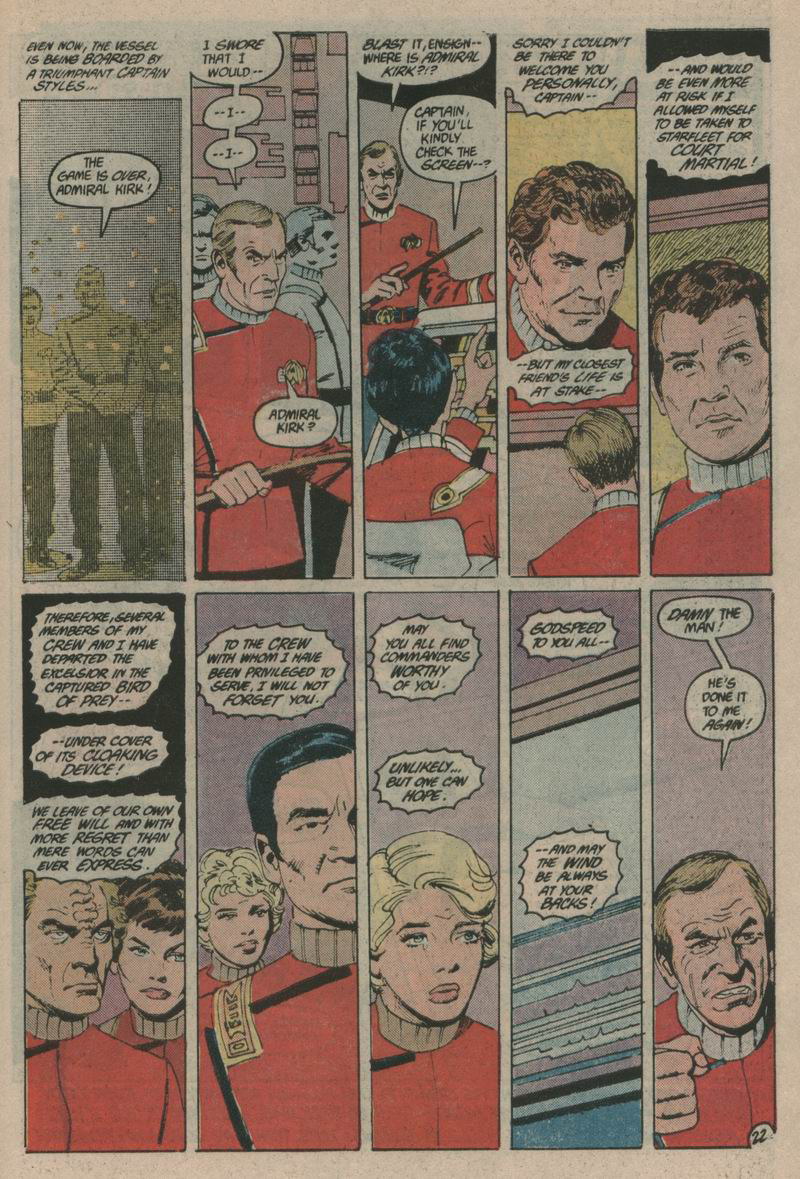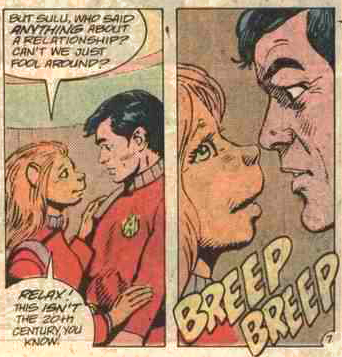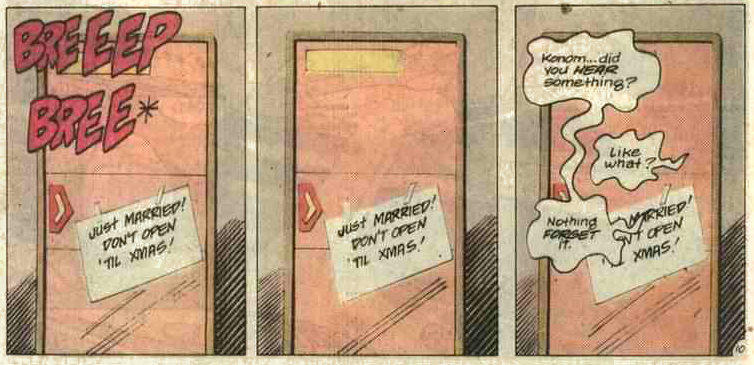Licensed to Cash-In: DC's Star Trek
In the previous article, we had taken a look at how Star Wars' early expanded universe thrives under Marvel's army of writers and artists wanting to take a crack at a galaxy far, far away. It lasted for 107 issues and was genuinely a tapestry of great stories, original characters, and unique takes on the mythos never seen again. This time, we go through the looking glass to the as polar opposite as we can go:
DC's own run on Star Trek.
Premiering in February of 1984, Star Trek was well into its second span of popularity. The series had come back in movie form, with both The Motion Picture and The Wrath of Kahn shaking things up drastically. Spock was dead as of the latter movie, and Savvik has taken his place as ship Vulcan and Science Officer. Since the films had also established that Kirk had long since been promoted out of the Captain's chair into a desk job, writer Mike W Barr (who had written an issue of Marvel's own ill-fated Star Trek comics based on the first movie) had to come up with some smart way to make sure the crew was together.
Yeah, it was kinda easy.
Joining Barr on his Star Trek were artists Tom Sutton and Ricardo Villagran, along with letterer John Costanza and Michele Wolfman. The fundamental pitch was that the Klingons were miffed over various offscreen slights, and were close to declaring war on the Federation. The story would end with Konom, a Klingon warrior with what some would consider a conscience defecting and would eventually join the Federation in a bizarre prediction of Worf from spinoff series The Next Generation.
However, another movie would fast approach. Star Trek 3: the search for Spock would hit theaters in later 1984. The special released for the movie would side-step the misadventures of Kirk and crew, which was only 8 issues deep at this point. The books would also advertise the film, but wouldn't set things up directly for the third movie either. What happened would be a rather bipolar special when mixed in with the movie canon, but Barr certainly did his best to keep the mood up with what happened next.
Issues 9 through 16 would set up a new status quo for the franchise. Titled New Frontiers, this would also be Barr's last story on the book. With Spock restored from his death on the Genesis Planet in the previous movie, the story at first launched with Kirk trying to pick up the shattered pieces of his life. His son David Marcus was dead, and someone had to tell his mother.
Star Trek was a little more serious than Star Wars.
The crew started to pick up the pieces of their lives and move on, but the threat of court-martial still looked over Kirk's head. However, a twist literally no one saw coming hit with the final page of the comic:
The Mirror Universe was somehow back, and actually out for revenge. This time, it wouldn't be just Kirk and a few friends accidentally crashing into another universe, it would be an outright invasion from one world to the next. With the mirror Enterprise running amuck in the prime universe, the Excelsior was called in to bring this renegade Federation ship down. Having picked up Kirk and crew earlier, the Excelsior's Captain Styles was more than happy to brag about his ship…
Until the mirror crew captures it, of course.
What would result in, a trade of vessels, destruction of the other Enterprise, and a complete revolution of the mirror universe from within… led by the mirror version of David Marcus. Realizing that the Federation was saved once more by Jim Kirk, Starfleet would give him another ship to keep him from getting bored: the Excelsior itself. To prevent future writers from getting written into corners, Barr gave Spock his own ship, the science vessel Surak, and even kept the stolen Klingon vessel from the third movie inside the Excelsior.
Len Wein would take over as head writer in issue 31 after a smattering off fill-in writers and other small stories. Len Wein would have to deal with something that Barr once had to deal with, though: a pending movie… and the 20th anniversary of the franchise!
Issue 33 would celebrate the 20 years of Star Trek, with something only possible in the realm of written word and comics:
A crossover between the original series of 20 years before and the current crew of the Excelsior! Titled Vicious Circle, one of the original show's time travel adventures went awry, and the ship was hurled further into the future than intended. Washing out of the timestream next to the Excelsior, both crews found themselves having to work together to prevent the destruction of the universe. This was, frankly, a fantastic excuse to use the original series designs and likenesses, making for some memorable encounters back in the day.
However, Len Wein would also have to adjust for the fourth Star Trek movie: The Voyage Home. With an early script in hand, it looked like Star Trek 4 would happen right after 3, potentially wrecking everything set up in the comics between! Instead of pulling a retcon out of nowhere, Wein came up with a three part story designed to wreck things enough back to status quo: The Doomsday Bug.
Relationships with the Romulans were starting to break down, and open war was looming. To make matters worse, a Starfleet officer was now the carrier of a deadly virus that wipes out life like a frat boy wipes out kegs. The Romulans, not one to wait for trivialities like war, figured that Kirk going to stop the carrier from infecting more people was the perfect cause to start a war... only for their own people to be turned into some kind of zombies by the plague. In the end, Spock's ship, the Surak, was sent hurling into a sun, Spock's brain was wiped back to factory settings, and the crew was now a bunch of renegades in a Klingon bird of prey hiding out on the planet Vulcan.
And the best part is, the story didn't feel forced at all. Well. Much, anyhow.
After getting the crew used to the new Enterprise-A and setting off on more missions after the movie, Len Wein would bow out as the writer. Michael Carlin would take over as head writer for Star Trek up to issue 41. He would do several short stories with the same art crew as ever, including some tales with Kirk having to face up to his past decisions and his reputation as a lawbreaking cowboy.
Then Peter David came in with issue 48. The original characters Konom and Crewman Nancy would actually get married in the first interspecies Star Trek relationship between main characters, and a half-human half-Klingon child would also be rescued from a devastated Klingon colony, destroyed by a Starfleet vessel! Like Konom himself predating Worf, this would be a hint of things to come with Worf's son Alexander.
Peter David would also bring his brand of humor to the series, with subtle sarcasm and wit being added to the already barbed tongues of the crew of the Enterprise-A.
Or the occasional pop culture references he so loves.
As someone who grew up with Berkley Brethered’s Bloom County, this brought a massive smile to my face.
David would also bring a more adult angle to book without breaking the Comics Code Authority.
The humor and adult situations would reach a fever pitch, however, with issue 53: you're dead, Jim!
Stabbed in the heart and left for dead by regular character William Bearclaw, Jim Kirk was left clinging to life by a thread while friends remembered their best and worst times with Jim. Barely surviving, the story turned into a murder whodunit as it turned out Bearclaw had been impersonated by a shape-changer! It was up to Kirk's old academy rival Finnigan to help find the real criminal and save the day.
Played by an older Green Arrow, it seems.
The series would end with issue 56 in 1988, but not for lack of sales. You see, DC had just landed the license for the hot new Star Trek tv show, The Next Generation. They took the opportunity to launch a brand new line of Star Trek comics with a small gap in publishing. In the meantime, DC would release a special for Star Trek 5: The Final Frontier. With this relaunch, the art teams would change out, but Peter David would stick on for a few more issues.
Unfortunately, a lot of these issues will need to be found in back issue bins. Unlike Star Wars, with Marvel and Dark Horse ensuring that the old 1970s Marvel books won't ever be out of print, the DC books have languished in obscurity ever since. There was a collection for the New Frontiers storyline (twice), a collection for Peter David's run on the first volume (which may be UK only, as my copy only has their pricing on it), and two different collections for the first storyline of the volume. All the issues in between, including the seminal Len Wein issues, are stranded in back-issue bins across the world.
The subsequent volume 2 would last for another 80 issues, although the ongoing plots would end soon after the release of Star Trek 6: The Undiscovered Country. This would also slow the sales of the book, but the same would apply to the TNG books as well. But the real reason for the cancellation?
Marvel had snagged the license from DC, much like how DC had snagged the license from Marvel earlier, just in time for the new movies and TV shows to be released in the late-1990s. But that could be a story for another day.





















